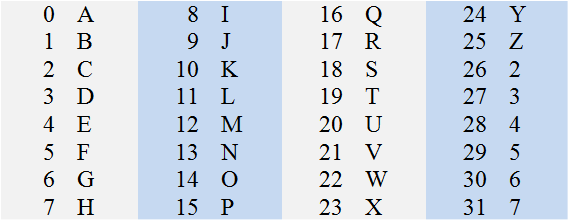Base32 Encoding - The Basics
 Cloud Tuned
Cloud Tuned
Base32 Encoding
Base32 encoding is a method for converting binary data into a text format using a set of 32 different characters. It is used to encode binary data in situations where text-based formats are required, such as in URLs, file names, or data exchange formats. Base32 encoding is more space-efficient than Base64 for some applications, though it results in a larger output compared to Base64.
Key Aspects of Base32 Encoding
1. Character Set:
- Base32 uses a set of 32 characters: A-Z and 2-7. This choice avoids ambiguous characters like 1 and 0, which can be confused with I and O.
- The alphabet is specifically chosen to be case-insensitive.
2. How It Works:
- Base32 encoding divides the binary data into groups of 5 bits and maps each group to one of the 32 characters.
- Each Base32 character represents 5 bits of data.
- Padding with = characters is used to ensure the final output is a multiple of 8 characters.
3. Padding:
- If the input data is not a multiple of 5 bytes, the output is padded with one to seven = characters to make it a multiple of 8 characters.
- This padding ensures proper decoding back to the original binary data.
Base32 Encoding Process
1. Convert Input Data to Binary:
- For example, the ASCII string "Hi" is represented in binary as:
H: 01001000 i: 01101001
2. Group the Binary Data into 5-bit Chunks:
- Combine the 8-bit bytes into one sequence and then divide it into 5-bit groups:
01001 00001 10100 1
- If necessary, pad the final group with zero bits to make it a full 5-bit group.
3. Map the 5-bit Groups to Base32 Characters:
- Using the Base32 alphabet, map each 5-bit group to the corresponding Base32 character:
01001 (9): J 00001 (1): B 10100 (20): U 10000 (16): Q (padded)
- The encoded string for "Hi" is "JBSQ====".
Example
Let's encode the string "Hello" using Base32:
1. Convert to Binary:
H: 01001000 e: 01100101 l: 01101100 l: 01101100 o: 01101111
2. Group into 5-bit Chunks:
01001 00001 10010 10101 10110 11000 11011 01111
3. Pad the Data:
- The binary data is padded with zero bits to make the last group 5 bits long:
01001 00001 10010 10101 10110 11000 11011 01111
4. Map to Base32 Characters:
01001 (9): J 00001 (1): B 10010 (18): I 10101 (21): V 10110 (22): W 11000 (24): Y 11011 (27): 3 01111 (15): P
- The encoded string for "Hello" is "JBSWY3DP".
Base32 Alphabet Table
+-------+------+-------+------+-------+------+-------+------+
| Value | Char | Value | Char | Value | Char | Value | Char |
+-------+------+-------+------+-------+------+-------+------+
| 0 | A | 8 | I | 16 | Q | 24 | Y |
| 1 | B | 9 | J | 17 | R | 25 | Z |
| 2 | C | 10 | K | 18 | S | 26 | 2 |
| 3 | D | 11 | L | 19 | T | 27 | 3 |
| 4 | E | 12 | M | 20 | U | 28 | 4 |
| 5 | F | 13 | N | 21 | V | 29 | 5 |
| 6 | G | 14 | O | 22 | W | 30 | 6 |
| 7 | H | 15 | P | 23 | X | 31 | 7 |
+-------+------+-------+------+-------+------+-------+------+
Applications of Base32 Encoding
1. URL Safe Encoding: Base32 is often used for encoding data in URLs and file names because it avoids characters that have special meanings in these contexts.
2. Data Encoding: Used in various applications such as encoding cryptographic keys, tokens, and identifiers where case-insensitivity and readability are important.
3. TOTP (Time-based One-Time Password): Base32 is commonly used to encode shared secrets in two-factor authentication systems like Google Authenticator.
Decoding Base32
To decode a Base32 encoded string, the process is reversed:
1. Replace each Base32 character with its 5-bit binary representation.
2. Group the bits into 8-bit bytes.
3. Convert the bytes back to the original binary data.
Example in Python
Here's a simple example of encoding and decoding using Python:
import base64
# Encode
original_data = b"Hello"
encoded_data = base64.b32encode(original_data)
print(encoded_data) # Output: b'JBSWY3DP'
# Decode
decoded_data = base64.b32decode(encoded_data)
print(decoded_data) # Output: b'Hello'
In summary, Base32 encoding is a useful technique for converting binary data into a text format that is safe for URLs, filenames, and other text-based formats. It ensures that binary data can be transmitted and stored in environments that only support text, while also being case-insensitive and avoiding ambiguous characters.
Subscribe to my newsletter
Read articles from Cloud Tuned directly inside your inbox. Subscribe to the newsletter, and don't miss out.
Written by
